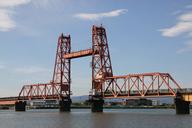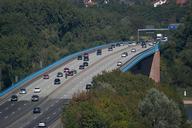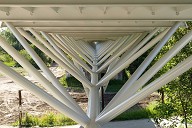Floating expansion joints for Europe’s largest lift bridge
Rotterdam has the largest port in Europe, so its port entrance for overseas container ships is both vast and congested. This is the entrance to what is currently the largest lift bridge in Europe: the Botlekbrug. Opening and closing a bridge of this size represents uncharted territory. It requires special bearings and expansion joints which MAURER has developed specifically for this purpose. These can be opened and closed.
Media
The new Botlekbrug is part of a 37 km motorway section of the A15 that passes through Rotterdam port and is being widened by order of the Rijkswaterstaat. The consortium A-Lanes A15 comprising Ballast Nedam, Strukton, STRABAG and John Laing was in charge of this operation. A-Lanes A15 will also operate the bridge.
Botlekbrug consists of two directly adjacent lift bridges both with three motorway lanes in each direction and up to two railway lines. Each bridge is around 100 m long and 50 m wide. The pylons are around 60 m high.
The bridges do not open up completely – that would no longer be feasible with these dimensions. They move up to 40 m upwards. In terms of pure numbers, they are designed to open six times an hour. "This means they are basically more like machines than bridges", explains Holger Redecker, branch manager of MAURER in Lünen, Germany. They require particular expansion joints and have specific load types for the bearings.
Extra joint only for opening
A MAURER DS 720 swivel joist expansion joint is installed on the external passage of each bridge, while a MAURER DS 320 swivel joist expansion joint is installed on the internal passage. Swivel joist means that the individual plates are connected underneath moveable to a swivelling steel beam which opens and closes and this ensures that the clearances between the plates open evenly. Yet while an expansion joint is usually fixed to both banks, in the case of Botlekbrug, it has to be loosened. This first challenge was overcome by building a single-profile joint on each abutment side of the swivel joist. This is where the bridge opens. The swivel joist is suspended from the steel superstructure and moves upwards with the bridge.
Extra lifting beams
However, in order to ensure that it doesn't fall down, the new expansion joints have extra lifting beams as a second special feature along with the standard cross beams. These lifting beams are twice as long as the cross beams, must not be rigid and have to be integrated – a group of requirements that significantly compresses and complicates the steel construction. It would have been easier to integrate the single-profile opening on the bridge side – there was not enough space for the large expansion joint on the abutments.
Centering system with pins and funnels
Challenge number three was moving the bridge downwards, especially if it had been open for an extended period of time and had changed as a result of the heat, cold or wind. This meant that a centering system was required that was produced in the form of funnels and pins. Funnel-shaped constructions were installed in the abutments. The vertical 1.5 m long pins are mounted underneath on the expansion joints, impinge into these funnels when being lowered and pull or push the expansion joint into the right position. Castors are attached to the pins underneath to enable them to slide into the funnels and to centre themselves.
Spherical bearings with two planes
While a special effort is made to ensure there are lifting forces for a normal bridge in order to prevent the bearings from rising, the Botlekbrug has to be raised. However, the EN 1337 standard prohibits the opening of the slip plane.
As a solution to this, a second plane is installed for all 16 spherical bearings across the slip plane which can be opened. In contrast to the expansion joints, the plane bearings remain on the abutments and only the second plane moves upwards. The spherical bearings measure around 1,200 x 1,100 mm and weigh more than 4 t. The load amounts to 21,000 or 29,000 KN.
It goes without saying that all bearings also require centring mechanisms again when being closed. These devices are also built according to the funnel and pin principle. The pins for the spherical bearings are 30 cm long and are also equipped with a slide mechanism. 30 cm is sufficient because the bearing is mainly centred by the horizontal bearings.
Horizontal bearing pins centre the bearings
A special feature of Botlekbrug is the very high longitudinal and transverse loads. This means that additional horizontal force bearings are required: There are three additional bearings situated between the spherical bearings on each abutment: one for the transverse loads and two for the longitudinal loads.
These horizontal bearings also have the task of centring the bearing for the bridge. Instead of a funnel, a huge clevis which extends upwards is used here. When being closed, the vertical pin moves into the clevis from above and centres the bridge on the bearings. A clevis is up to 1 m wide, 3 m long and 1.80 m high. It weighs up to 15 t and is made of solid steel. They were cast in China, because this wasn't possible in Europe.
The pin and steel flank form the horizontal force bearing. The pin carries vertical spherical bearings on either side of the steel flank.
Complex development
The technical processing for MAURER innovations alone took two and a half years. When it comes to implementing a project with these challenges, it is no longer about following the standard tender procedure. It is more about if anybody is even able to find a technical solution. "I believe MAURER was the only company who was actually able to develop this solution," explains Redecker. Everything installed in Rotterdam were prototypes.
A test joint was built in Munich in order to be able to assess the movement of the bridge. 120 sensors and numerous employees will monitor the operation of Botlekbrug in Rotterdam around the clock – in a huge nacelle that is equipped with a gallery of screens as is the case at other headquarters.
MAURER carried out installation work from the end of 2014 (horizontal force bearings) to the early summer of 2015. The 2-billion-bridge was opened in July 2015.
References
Structure Types
- About this
data sheet - Product-ID
7309 - Published on:
11/01/2016 - Last updated on:
19/05/2017

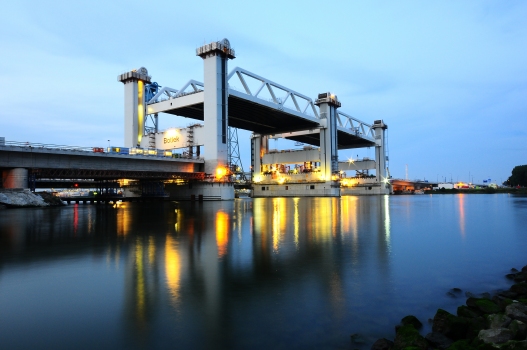
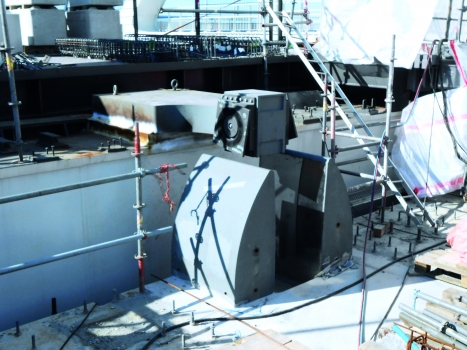
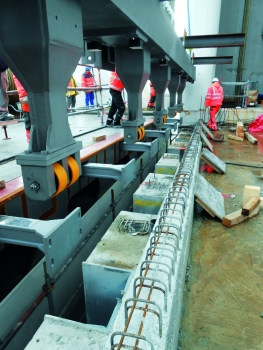
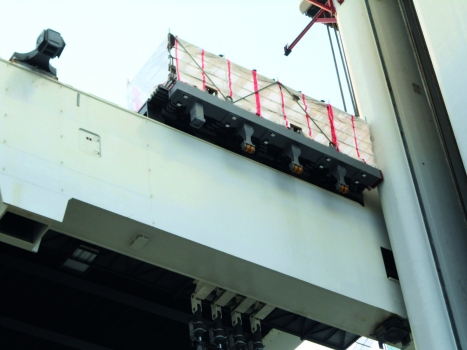
 MAURER SE
MAURER SE 
